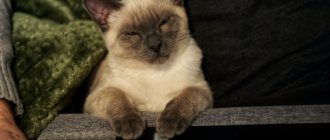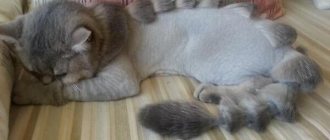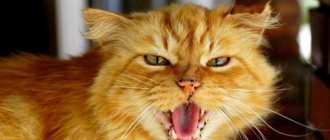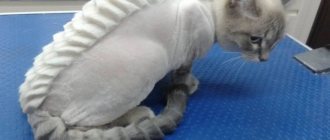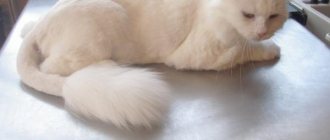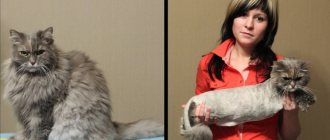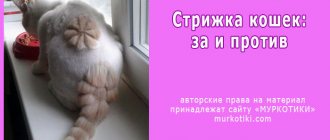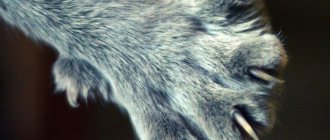Should your cat be groomed?
Before carrying out any manipulations with your pet, you need to figure out whether it really needs human intervention.
The animal's fur is often perceived by owners as an analogue of a good mink coat, which warms in both winter and summer. Some owners, in a fit of love, want to rid the cat of fur, thinking that this will help him survive the summer heat.
In fact, you need to approach this issue carefully. For example, Maine Coons and other semi-longhaired breeds have undercoats and guard hairs of varying lengths, and their beautiful long coats provide a natural layer that protects them from the heat. Therefore, improper haircut leads to overheating or hypothermia.
In what cases is the procedure indicated?
The truth is, cats don't need trimming regardless of the length of their fur. They know how to take care of themselves - they lick themselves, rub against hard objects, and shed regularly. Experienced owners help the cat take care of itself using special tools, do not skip washing time, and brush it regularly. If this is not done, the animal will need the help of a groomer.
In short, a haircut is indicated only in two cases:
- tangles appeared on the pet’s body;
- The pet is sick and needs access to the skin.
The remaining reasons for which the manipulation is carried out are not mandatory, but may be important for the owners.
- Neat appearance of the cat
- Stomach problems after licking a lot of fur.
- The cat does not allow itself to be brushed or bathed.
- The cat's inability to care for itself (old age or illness).
- Trying to control cat hair allergies.
There are studies that show that allergies are caused not by fur, but by protein from cat saliva, so hair removal will not get rid of cat allergies.
Pros and cons
As mentioned above, there are undoubtedly benefits from grooming cats. This includes relieving the animal of unpleasant sensations caused by the tightening of the skin by tufts of matted hair, alleviating the pet’s condition in the heat, and significantly reducing the amount of hair in the house during the cat’s molting. The latter is especially true for owners suffering from allergic reactions to animal fur, as well as for young children.
In addition, a haircut significantly transforms and ennobles even the most ordinary-looking cat and turns it into a beautiful and graceful animal.
However, in addition to the obvious benefits, haircuts also have their disadvantages. One of the most important negative aspects is a violation of the thermoregulation of the animal’s body, due to the fact that rough interference occurs in the natural skin conditioning mechanism provided by nature. As a result, after removing part of the fur, the animal’s body temperature changes, and it becomes vulnerable to drafts and direct sunlight.
Another weighty argument against cutting is the deterioration in the condition of the coat after regrowth. There are frequent cases of noticeable degradation of the hair structure and changes in color. But this is not the main thing, since the most dangerous consequence of cutting cats is the extreme stress that most animals experience, especially those getting their hair cut for the first time. After the procedure, many pets become seriously depressed and often become ill due to nervousness. It is also worth mentioning here the known cases of animals dying from cardiac arrest during shearing.
However, for the sake of fairness, it should be noted that such cases are isolated, and most animals quickly recover from fright and live their previous lives.
Considering the disadvantages, it is impossible not to mention that cats grow overgrown rather slowly, and there is no guarantee that the hair after shearing will ever reach its original length. Moreover, in the first few weeks after cutting, the hairs will remain quite prickly and not very pleasant to the touch. With very short haircuts, performed with attachments of 1 mm in length, the risk of damage to the pet’s skin during scratching increases significantly.
Therefore, cutting cats too short is very harmful and risky, and most of the problems that arise due to the animal’s long hair can be solved with regular grooming and thorough combing.
Types of haircuts
There are three types of haircuts. I propose to look at each type in more detail to understand what procedure your cat needs.
Medical haircut
This procedure is necessary if your pet becomes ill or undergoes medical intervention.
For example, if a cat has shingles, it needs to be trimmed to keep it safe and ensure quality treatment. Read about how to treat lichen in cats in my other article.
When you submit your cat for sterilization, doctors will definitely cut off some of the fur before the operation. Similarly, the cat's fur is trimmed or shaved before the IV is inserted.
This procedure is carried out according to indications and can be done directly in a veterinary clinic.
Hygienic haircut
To maintain the pet's hygiene, a hygienic haircut is performed. Its main purpose is to remove tangles and restore wool.
If you are unable to devote enough time to taking care of your pet’s hygiene, you should regularly visit the groomer and bring the animal for procedures that will further simplify caring for the cat.
Removing tangles is very important. Dirt accumulates underneath them and bacteria and parasites can multiply.
You can cut your cat’s hair for hygiene purposes at home, if you have the necessary tools and have mastered a simple technique, which will be discussed later.
Model haircut
This type is carried out solely at the request of the owner. Some people like it when their pet attracts attention due to the unusual shape of its coat, while others combine hygiene procedures with aesthetics.
Some owners get a model haircut before a photo shoot with a cat or do it several months before the exhibition.
Professional grooming
When it is not possible to trim or shave a cat on your own, or when it is being prepared for exhibitions, competitions, or photo shoots, it is recommended to contact specialized salons or professional groomers. They have experience and special tools, which eliminates damage to the vibrissae and skin trauma.
In salons, a haircut takes from 40 minutes to an hour - it depends on the complexity. To prevent the cat from being nervous about a trip or an unfamiliar place, you can call a specialist home. Anesthesia is rarely used; it disrupts the functioning of the cardiovascular and respiratory systems. The cost of a haircut varies from 700 to 1000 rubles.
Salon prices offer a full range of services - from ear cleaning to final styling. A professional groomer has a larger selection of tools - several types of combs, furminators, shaving machines, and different attachments. The photo shows how difficult it is to do haircuts. Without experience, you can even cripple an animal on your own.
If necessary, the cat is given an injection of a sedative. After the haircut, they will tell you how to properly care for it and when it is necessary to do it again. Only professionals can do a model haircut before a competition; at home, the risk of ruining it greatly increases, and you can injure the animal.
Is it possible to shave a cat's head? This cannot be done unless necessary, since wool saves the animal from the sun, heat, hypothermia, and accidental damage. It is strictly forbidden to shave your head. There are many sensitive vibrissae that cannot be injured. Cats are shaved bald when their fur is stained with substances that are difficult to wash off (cement, mortar, polyurethane foam), before surgery, or when the body is severely damaged by parasites.
How long does a cat's hair grow after shaving? This depends on various factors - the age of the animal, current diseases, nutrition. The fur usually grows back in 6 months. But in case of chronic diseases, deficiency of useful microelements, the cover takes several years to recover.
Grooming cats should be done carefully, carefully, so as not to injure the animal. The pet gets used to its new appearance in a few days. If you have any doubts about your abilities, it is better to contact a professional groomer.
How to prepare for a haircut
Before starting the procedure, choose a place for it - a spacious, flat surface. It is best to use a kitchen table. Remove all unnecessary items from it.
Enlist the help of an assistant. It is difficult to carry out the procedure alone, since it is quite lengthy. Stock up on treats for your pet.
Prepare the necessary tools:
- Trimmer for hard-to-reach and intimate areas.
- Scissors with blunt ends or a tangle cutter.
- Thinning scissors.
- A clipper (if the cat has long hair, you need a powerful electric clipper, at least 45 W).
I also recommend preparing the following materials:
- a thick towel to wipe the cat;
- a disposable diaper in case of an unexpected bowel movement;
- gloves for yourself and your assistant;
- thin comb and brush for combing;
- softening conditioner for combing;
- lubricant for the machine.
Important rules to know
Before starting the procedure, read the rules for its implementation.
- The paws, tail and head are never cut to zero. There are receptors there that allow the pet to navigate in space.
- The longer the machine runs, the hotter it gets. The cat may get burned.
- Do approaches for 10-15 minutes and take breaks, giving your pet time to rest.
- Leave at least 3 mm of fur on the skin, and preferably 1-2 cm.
- Do not press the blade close to the animal's body, as this may injure it.
- Be sure to lubricate the blade so it glides through the fur rather than tearing it.
- 2-3 days before the procedure, bathe your pet (read how to wash a cat in a separate article). However, if there are mats on your body that cannot be removed, postpone bathing.
Step-by-step instruction
It is possible to perform a simple haircut on an animal at home. The main thing is to prepare properly and know the simple rules. Wear thick gloves and have your assistant do the same. Place a towel at hand (in case you need to wipe the cat), tools, peroxide and cotton wool.
- Secure the cat on the work surface. It is best if the pet lies on its side. Your helper should press the cat's back and front paws to the surface.
- If you have not yet gotten rid of tangles, the time to do it is now. Try to separate the lump into fibers, which you then need to comb with a fine-toothed comb. If the tangle is large, cut it out with a tangle cutter or blunt-tipped scissors.
- Before grooming, comb your cat well and use a conditioner spray to remove any tangled hair and make the procedure more comfortable.
- After this, take small scissors or a trimmer and carefully go through the genital area, armpits, nipples and between the fingers.
- When the difficult stage is completed, take up the machine. Use a 3mm or larger comb and cut the fur first on the sides, then on the back and finally on the belly. Follow the growth of the fur. Lubricate the attachment with blade spray as needed.
- You can trim the fur on the paws with scissors.
- If desired, you can use thinning scissors at the end of the procedure.
If you see that your pet is tired or nervous, take a break, calm him down and give him a treat.
I really liked the video about how to groom a cat at home, where the author clearly shows how you can cope with this difficult task in 15 minutes. I hope it will be useful to you too:
How to trim or shave your pet if necessary?
Hairdressing procedures at home are carried out according to a certain algorithm:
- Trimming nails. It is carried out with special tweezers, pre-disinfected. Light pressure on the paw pads causes the hidden claws to extend; the owner only needs to trim the very tips. This procedure will prevent scratches during cutting.
- When performing the initial manipulation, an assistant is needed - he must hold the animal, preventing it from running away. Some cats become aggressive when they see grooming tools. For safety, the pet is wearing a plastic collar that prevents it from biting.
- The cat is laid on its side, its paws are securely fixed. For cutting, use a clipper or scissors. The first will avoid damage to the skin, but can irritate and frighten the pet with its buzzing.
- The fur is removed from the sides, then moved to the back and belly. Hair removal is carried out both in the direction of its growth and in the opposite direction. The remaining long hairs are trimmed with nail scissors. There must be a tassel on the tail.
What to do if the cat is aggressive
When it is possible to prepare for stressful manipulations, it is better to do so. If you know that your pet will be aggressive, take care of his comfort and your peace of mind in advance.
You can put a protective collar on your cat to protect him from being bitten.
According to the doctor's indications, you can give herbal sedatives in advance to make the process easier.
If the condition of the fur is deplorable, there are tangles, and the cat is wild - only in such cases is anesthesia used. This is done on the basis that anesthesia will cause less harm than the existence of tangles with accumulated dirt and parasites. This procedure is carried out only in the clinic under the supervision of a veterinarian!
Varieties
Cat haircuts are divided into two groups: model and hygienic. The latter pursue very specific goals and are carried out in order to protect the animal from overheating and tangles, as well as for veterinary indications. These include diseases of the skin and gastrointestinal tract, increased secretory activity of the sebaceous and para-anal glands, as well as the senility of the pet, when it is no longer able to cope with its fur on its own.
Model haircuts are performed exclusively for decorative purposes to make the animal more attractive, as well as before cat shows. The most common of them are haircuts like a lion, like a dragon, and like a dinosaur. The puma hairstyle is also very popular and is a simplified version of the lion haircut. The only difference is the design of the tail: for example, if in a “puma” it is cut almost bald, then in a “lion” it repeats the shape of a real lion’s tail with a fluffy tassel.
However, the most creative can be called the “dragon” haircut, which includes various variations of cutting symbols, letters, ornaments and figures on the back of the animal. Despite the rather exotic appearance of the pet, most veterinarians warn owners against performing this haircut. This is due to the fact that after cutting the patterns, the fur on the pet’s skin becomes uneven, which greatly disrupts thermoregulation and does not allow the body to adapt to this type of heat transfer.
A graduated hairstyle has a much stronger negative impact on the cat’s condition than uniform haircuts, to which the body adapts over time. The same, but to a slightly lesser extent, applies to the “socks”, “sock socks” and “puss in boots” haircuts, which are also very popular among cat owners. Among exhibition haircuts, “harlequin”, “modern” and “continental chic” are very popular.
What to do after a haircut
After the procedure, calm the animal down and give it a treat. You need to wipe the cat with a towel and comb it. If possible, bathe the animal and dry it properly. Be prepared for the fact that after the procedure the hair may change structure.
The pet's behavior may also change: a vengeful animal may take a shit, a timid animal may hide in dark places. If a cat is hiding in a warm place, it means she is cold. Help get through the fur growth period by dressing your cat in warm clothes and keeping his resting area warm. For the next cut, take note that the previous length brings discomfort to the cat.
